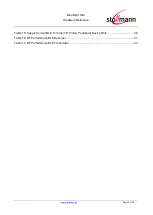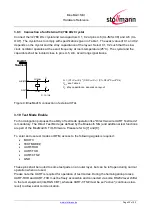
S/AI
Hardware Reference
Page 14 of 52
3.4 Serial Interface
The serial interface of S is a high-speed UART interface supporting RTS/CTS flow
control and interface-up/down mechanism according to the UICP+ protocol (refer to [3] ). Electrical
interfacing is at CMOS levels (defined by VSUP; see chapter 5.5.1).
•
Transmission speeds are 9600 – 921600 bps and 1Mbps (asynchronous)
•
Character representation: 8 Bit, no parity, 1 stop bit (8N1)
•
Hardware flow-control with RTS and CTS (active low)
Note: Transmission speed may be limited by firmware. See corresponding command reference
[5] for further information.
S
Host
UART-RXD
UART-TXD
UART-CTS#
UART-RTS#
IUR-IN#
IUR-OUT#
Figure 4: Serial Interface Signals
The basic serial interface (with RTS/CTS flow control) uses only four signal lines (UART-RXD,
UART-TXD, UART-CTS#, UART-RTS#). IUR-IN#, IUR-OUT# and GPIO[4] (see below) can be left
unconnected.
A substantially saving of power during idle phases can be achieved (see 5.6.1) when the UICP
protocol is used (refer to [3] ). This protocol should be implemented on the host side as well.
Signals IUR-IN# and IUR-OUT# should be connected to the host and may be mapped to DSR and
DTR, if an RS232-style (DTE-type) interface is used (see Figure 5).
When using the TIO firmware and applications, call control can be supported by GPIO[4]. Driving
GPIO[4] to logic High level during a data transfer phase will “hang up” the connection and
disconnect the Bluetooth link. This signal may be mapped to DSR, if an RS232-style (DTE-type)
interface is used. Please refer to [5] for a functional specification. GPIO[4] can be left unconnected
if this feature is not used.















































